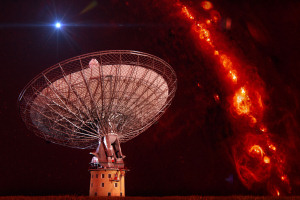Jul 5 2013
The international research team, writing in the journal Science, rule out terrestrial sources for the four fast radio bursts and say their brightness and distance suggest they come from cosmological distances when the Universe was just half its current age.
 CSIRO's Parkes radio telescope, which has been used to confirm a population of Fast Radio Bursts, is shown superimposed on an image showing the distribution of gas in our Galaxy. An artist's impression of a single fast radio burst is shown located well away from the Galactic plane emission. Fast radio bursts are a new population of radio source located at cosmological distances.
CSIRO's Parkes radio telescope, which has been used to confirm a population of Fast Radio Bursts, is shown superimposed on an image showing the distribution of gas in our Galaxy. An artist's impression of a single fast radio burst is shown located well away from the Galactic plane emission. Fast radio bursts are a new population of radio source located at cosmological distances.
The burst energetics indicate that they originate from an extreme astrophysical event involving relativistic objects such as neutron stars or black holes.
Study lead Dan Thornton, a PhD student at England’s University of Manchester and Australia’s Commonwealth Scientific and Industrial Research Organisation, said the findings pointed to some extreme events involving large amounts of mass or energy as the source of the radio bursts.
He said: “A single burst of radio emission of unknown origin was detected outside our Galaxy about six years ago but no one was certain what it was or even if it was real, so we have spent the last four years searching for more of these explosive, short-duration radio bursts. This paper describes four more bursts, removing any doubt that they are real. The radio bursts last for just a few milliseconds and the furthest one that we detected was several billion light years away.”
Astonishingly, the findings – taken from a tiny fraction of the sky – also suggest that there should be one of these signals going off every 10 seconds. Max-Planck Institute Director, co-author and Manchester professor, Michael Kramer, explained: “The bursts last only a tenth of the blink of an eye. With current telescopes we need to be lucky to look at the right spot at the right time. But if we could view the sky with ‘radio eyes’ there would be flashes going off all over the sky every day.”
The team, which included researchers from the UK, Germany, Italy, Australia and the US, used the CSIRO Parkes 64metre radio telescope in Australia to obtain their results.
Author Professor Matthew Bailes, from the Swinburne University of Technology in Melbourne, thinks the origin of these explosive bursts may be from magnetic neutron stars, known as ‘magnetars’. He said: “Magnetars can give off more energy in a millisecond than our Sun does in 300,000 years and are a leading candidate for the burst.”
The researchers say their results will also provide a way of finding out the properties of space between the Earth and where the bursts occurred.
Dr Ben Stappers, another author from Manchester’s School of Physics and Astronomy, said: “We are still not sure about what makes up the space between galaxies, so we will be able to use these radio bursts like probes in order to understand more about some of the missing matter in the Universe. We are now starting to use Parkes and other telescopes, like the Lovell Telescope of the University of Manchester, to look for these bursts in real time.”
The institutions involved in the collaboration were the University of Manchester’s Jodrell Bank Observatory, the Max-Planck Institute for Radio Astronomy, Bonn, the INAF-Cagliari Astronomical Observatory and the Cagliari University, Sardinia, Swinburne University of Technology, Melbourne, the Commonwealth Scientific and Industrial Research Organisation (CSIRO), Sydney, the Australian Research Council Centre of Excellence for All-Sky Astrophysics (CAASTRO), Curtin University, Western Australia, West Virginia University, US, and the NASA Jet Propulsion Laboratory, California.